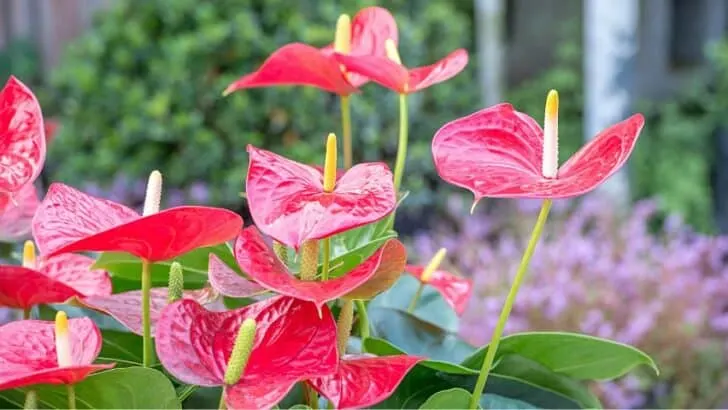How cold can Anthurium tolerate? Anthuriums, such as the Flamingo flower, grow in tropical forests from Colombia to Ecuador, according to Missouri Botanical Garden, where houseplants are native to influence the temperature they prefer and need.
I grow all my aroid plants in a grow tent. The grow tent is in a winter garden in Switzerland. Therefore I have a lot of experience with the maximum cold temperatures Anthurium plants can tolerate.
Table of Contents
How Cold can Anthurium Tolerate?
The minimum temperatures an Anthurium can tolerate are 60 degrees Fahrenheit (15.5 degrees Celsius). Below that level, Anthuriums will wilt. Foliage and flowers will droop. The cold damage will leave lasting damage. At temperatures below 50 degrees Fahrenheit, leaves, and stems become brown.
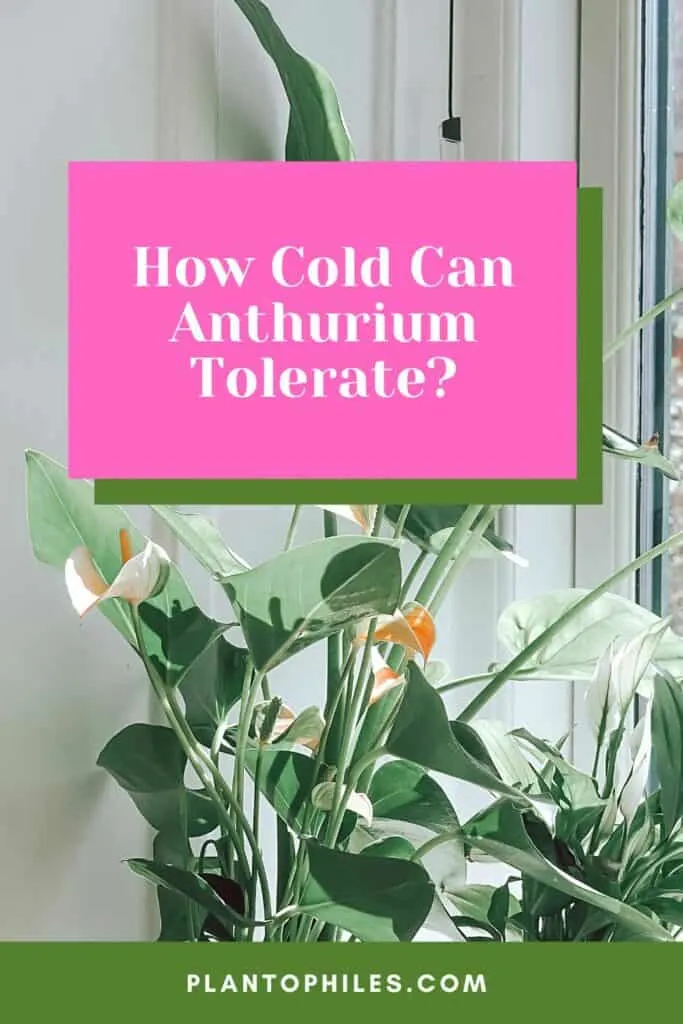
Anthurium Temperature Tolerance
The ideal temperature for Anthurium is 77-92°F (25-32°C). Temperatures above 92 degrees Fahrenheit (32 degrees Celsius) lead to quicker water evaporation from the leaves. The College of Life Science says that photorespiration increases and the capacity to conduct photosynthesis decreases.
The painter’s palette and other Anthuriums start to grow slower and slower. The same holds true for cold temperatures. Once temperatures are below 60 degrees Fahrenheit, the growth rate becomes much slower and will halt.
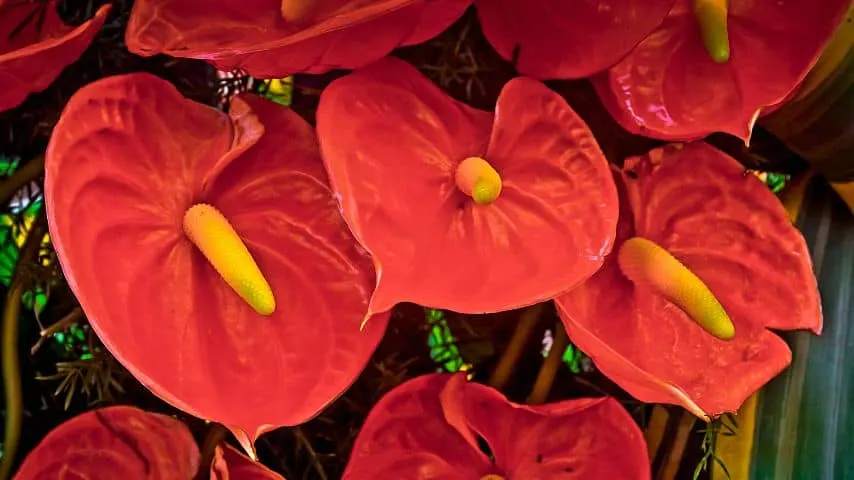
Anthurium Humidity Tolerance
The minimum humidity level for an Anthurium is 50%.
The optimal humidity for an Anthurium plant is between 70-80%. If the humidity is too high, plant leaves stay wet constantly if the air ventilation is insufficient. This leads to fungus and bacteria starting to build on the leaves. The leaves will become yellow and brown.
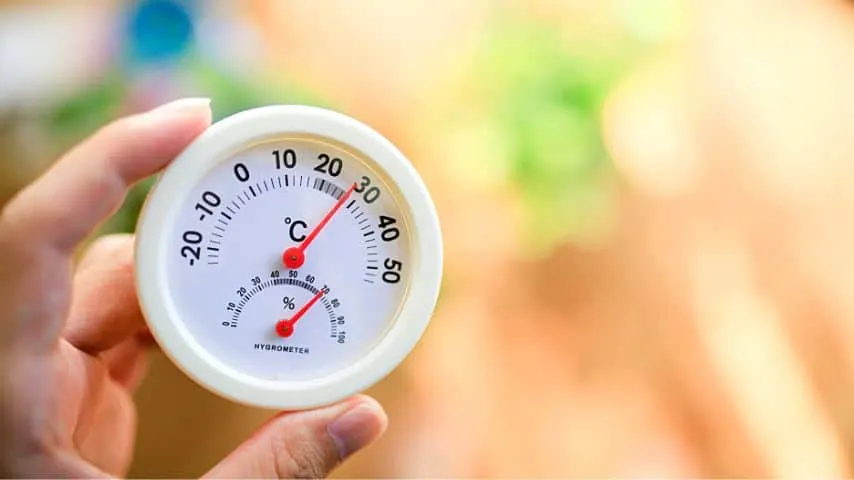
High humidity levels, even 90% to almost 100%, are possible as long as the leaves stay only wet for only 10-15 minutes at a time.
A humidity of 50-70% is still acceptable for Anthuriums. Most Anthuriums do ok at these levels. The main difference I observed is that higher humidity levels lead to the vigorous growth of aerial roots. As most anthuriums are epiphytes, aerial roots are essential for these indoor plants to hold onto other plants and objects.
The better these plants are attached, the thicker their stems will grow and the larger the leaves will get. The plants will also grow faster. In addition, high humidity makes it faster for Anthuriums to unwrap new leaves.
I have several Anthurium warocqueanum, Anthurium metalliicum, and Anthurium veitchii plants in my collection. At lower humidity levels, around 40-50%, at least the Anthurium warocqueanum gets crispy leaves on the edges. The leaf tip is also likely to become brown and crisp.
I also observed that the Anthurium veitchii and metallicum have difficulty unwrapping new leaves. A recent leaf of the Metallicum was stuck due to low humidity. The result was that the new leaf now had several holes where it was stuck to the rest of the plant.
At humidity levels below 50%, plant growth slows down considerably. New leaves have a hard time developing and get stuck. Aerial roots grow slower, and the plant has a slower growth rate altogether.
Signs Your Anthurium Plant is Not Growing in Ideal Temperature
Signs of low temperatures are wilting foliage. Browning and also blacking of leaves occurs. The leaves, petioles, and stems start wilting and simp. The wilting foliage turns brown and black and falls off.
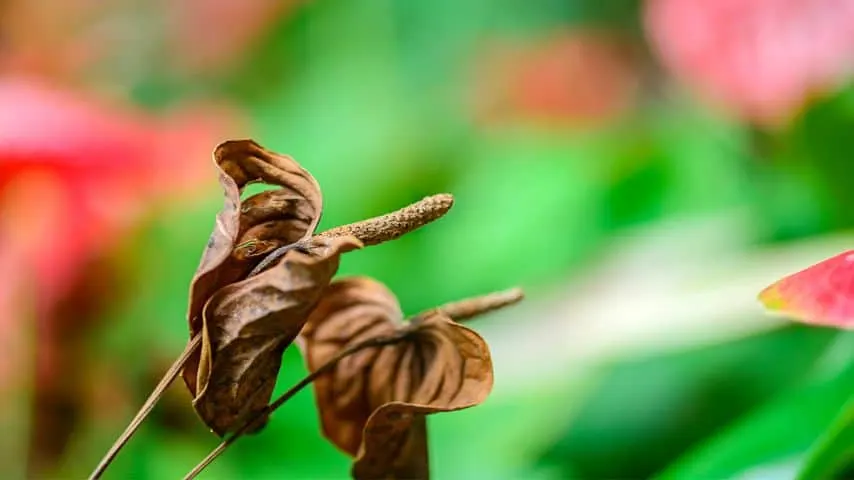
The stems deflate and become soft. These symptoms are often spotted when a plant arrives with cold damage, or you forget to bring it indoors when the temperatures get colder.
Signs of high temperatures are that the foliage becomes crisp and brown. Leaf spots that are browning can also be observed.
As the temperature increases, the lower the humidity will be. The reason is that hot air will hold fewer water particles.
Further signs according to Oregon State University, further signs are leaf rolling, blossom rot, fruit drop, ozone damage, and bolting.
Bolting is when plants develop fruits too early and prematurely. I spotted this phenomenon many times with my pepper plants.
Signs the Humidity Level for your Anthurium is Not on Point
In low humidity, Anthuriums develop smaller leaves. Leaves wilt and become brown. Common signs are crispy leave edges and crispy leaf tips. The foliage starts browning. The browning continues until the leave wilts and falls off. Leaf yellowing is also common.
In addition, the growth of the plant rate decreases. It takes longer for newer leaves to emerge and develop.
Air roots are slower to develop. Fewer air roots will emerge, and the Araceae plants have a harder time attaching themselves to moss poles and trellises. These are essential for climbing and vining plants.
Care for Anthurium in Winter
In winter, keeping Anthuriums away from drafty windows and heating units is essential. The microclimate directly in front of a window differs from 10-15 inches away (25-38cm). Houseplants that are too close to a window in winter are exposed to much colder temperatures. Cold drafts from windows are also common.
Heating units, on the other hand, produce warm and dry air. The humidity close to a heating unit is also much lower. 40% or lower is common. Radiators will dry out plants and potting medium much quicker. Therefore you need to keep Anthuriums away from heating units.
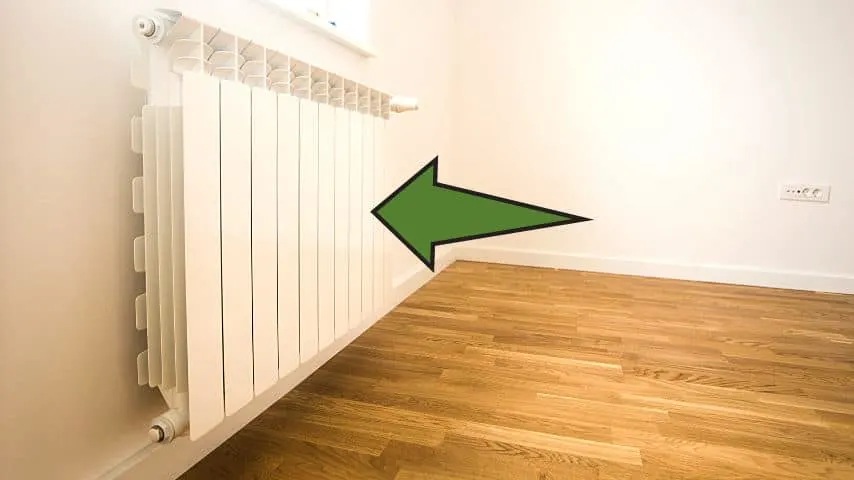
Provide a humidifier; use a pebble tray underneath the pot to keep the humidity high in winter. Spraying your plants is not advised based on my experience. I could not measure any substantial increases in humidity.
The danger of spraying your plants is that the leave stays wet for too long. This leads to fungus and bacteria, such as bacterial leaf blight, caused by Xanthomonas.
Keep Your Anthurium Warm
The best ways to keep your Anthurium warm are by keeping it away from windows in winter. Artificial lighting in the form of LED and growth lights is another way to keep anthuriums warm. The lights also emit warmth. Depending on the wattage and making of lights, the heat emission varies.
The distance from the plant also has a key role. The closer the lights are, the warmer it gets.
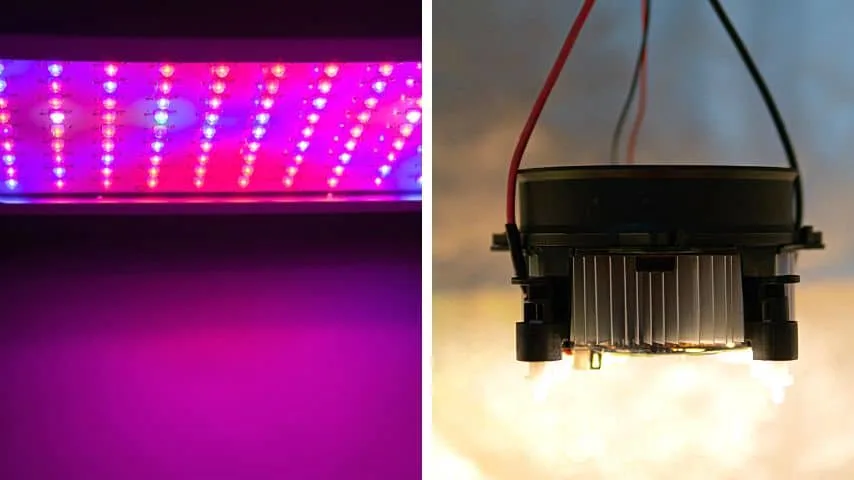
I am also using additional heating units set to hold a minimum temperature and go off whenever the temperature falls below the threshold. Since heating has become expensive, I am using a growth tent. A grow tent is a great way to keep your plants warm. Because the smaller a room is, the easier and cheaper it is to keep it warm.
I aim for at least 69 degrees Fahrenheit (21 degrees Celsius) for my Anthuriums.
Increasing The Humidity For your Anthuriums — The How-tos
The best ways of adding humidity to your Anthurium plants are:
- Use a humidifier
- Use a pebble tray
- Put plants closely together
- Use a terrarium or vivarium
- Plastic containers are great for smaller plants
Misting will not increase humidity around your plant for a prolonged time.
Indoor Anthurium Flower Plant Care
The Best Temperature Range for Anthurium Plants Indoors
The ideal temperature range is 77-92°F (25-32°C).
The Best Humidity Range for Anthurium Plants Indoors
The optimal humidity range is 70-80%.
Soil
Use well-draining potting soil. A soil using chunky bits such as perlite, charcoal, and orchid bark is optimal. This allows for air pockets to form in the soil mix.
Anthurium roots need airflow. A potting mix using charcoal, orchid bark, perlite, peat, or potting soil is great for Anthurium.
Water
Water about once every seven days. Test the soil and water once the soil is almost drying out.
Use your index finger and only water when the top 1-2 inches are almost dry to the touch (2.5-5cm). Overwatering can lead to root rot. Use a pot with drainage holes.
Light
Bright yet indirect light is ideal for anthuriums. Direct sunlight can scorch and burn the foliage. It’s advised anthuriums shouldn’t be exposed to direct sunlight for longer than 4 hours of direct sunlight.
An eastern or western-facing window is ideal. A couple of hours of direct sunlight in the morning of about 4 hours in a western-facing window is perfect. This is when the sun is not too hot, and its rays aren’t too intense.
Fertilizer
Fertilize anthuriums once a month in spring and summer. The main growing season for plants. Use a well-balanced fertilizer that you can dilute to 1/2 or 1/3 of its strength if you want to fertilize more frequently.
Refrain or reduce fertilization in autumn and winter. Following this regimen, indoor plants have all the nutrients they need when actively growing. The main macronutrients are Nitrogen, phosphorus, and potassium.
Some essential Micronutrients are zinc (Zn). manganese (Mn), iron (Fe).
Repot
Repot about once a year once the plants become almost root or pot-bound. Anthuriums need sufficient soil and space to grow new roots.
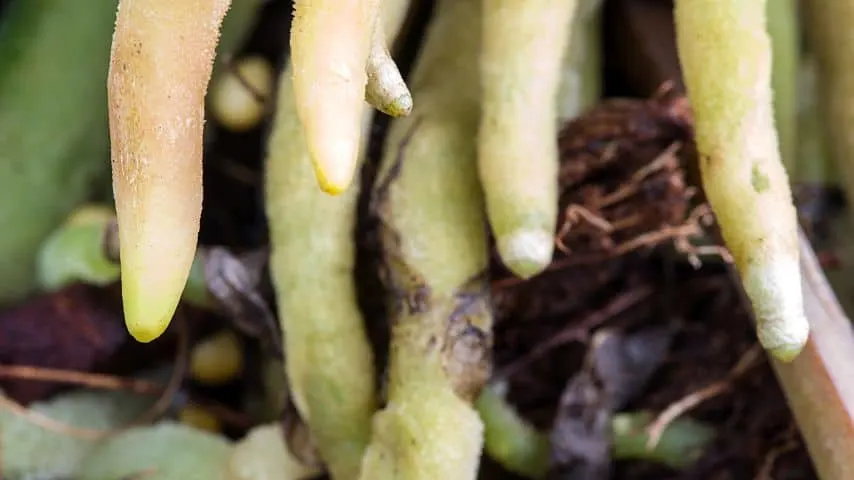
After a while, there will eventually be more roots and lesser soil in the pot.
Pruning
Anthuriums do not need to be pruned. But, it’s best to take it off whenever you see wilting and dying foliage.
Aside from being unsightly, it can also host plant pests.
Propagation
Anthuriums can be propagated by separation, from seeds as well as through stem cuttings.
Anthurium Outdoor Care
Anthurium care outdoors is similar to indoor care. The main difference is the sun exposure. The direct sun is very intense. This is why Anthuriums are grown best under semi-shade or shade outdoors. You can use shade cloth or use neighboring trees in your garden.
Depending on your climate, plants can stay outside in the tropics and neotropics all year. If you’re living in the USA (United States of America), you can grow Anthuriums in USDA hardiness zones 11-12.
If you live in the central or northern USA and most parts of Europe, you can grow Anthurium outside from summer to autumn. I put my plants out in later spring when temperatures no longer fall below 60°F (15.5°C). I also take them inside in autumn once temperatures fall below this threshold.
Anthurium’s Native Growing Conditions
Anthuriums are native to tropical rainforests. The native growing conditions in Columbia are hot and humid.
Temperatures range between 67 – 87 degrees Fahrenheit (19-30.5 degrees Celsius). They are fairly constant throughout the year.
Anthurium plants grow in the understory of rainforests.
They get filtered, bright indirect light to light shadow. It rains multiple times a day. But since the soil is loose and well-draining and because there is a lot of air circulation, plants do not get root rot mostly.
The forest floor is rich in both humus and nutrients. As many aroid plants grow as epiphytes, they get most of their nutrients from debris, wind, and rainfall.
Some Anthuriums grow on the forest floor.
Another important factor is beneficial bacteria, as well as springtails and isopods.
This is why you can keep these plants in a terrarium in very humid conditions as long as you create a bioactive terrarium with microorganisms.

Daniel has been a plant enthusiast for over 20 years. He owns hundreds of houseplants and prepares for the chili growing seasons yearly with great anticipation. His favorite plants are plant species in the Araceae family, such as Monstera, Philodendron, and Anthurium. He also loves gardening and is growing hot peppers, tomatoes, and many more vegetables.

